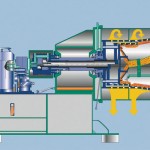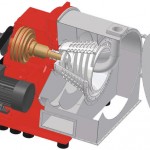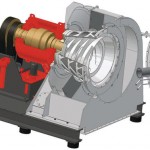The centrifuges from Siebtechnik are used in the most varied fields of the chemical and pharmaceutical industries. Here, the spectrum ranges from lactose production and the reprocessing of polymers as well as the manufacture of ABS and PVC right up to salt production. In the run-up to Achema, cpp paid a visit to the Muelheim traditional enterprise and spoke to Karl Bongartz, the managing director of Siebtechnik GmbH, Horst Dietschreit, technical head of the Centrifuges Department and Matthias Orth, technical head of pusher centrifuges.
SHS pusher centrifuges belong to the group of continuously operating filtering centrifuges. They are characterised by clear separation of the process, bearing and drive as well as the hydraulic mechanism. The rotor is appointed horizontally. This makes for easy accessibility to the product side and the drive. The centrifuges comprise various components. The basic element is the bearing housing. It incorporates the bearing, the rotor and pusher drive as well as the pump unit, including the electro-hydraulic control system.
Separate processing chamber
The product housing is cantilever-flanged on the bearing housing. It is divided up into the filtrate and solids compartment. Likewise cantilever-attached are the product-contacted rotor and pusher parts. The outer basket jacket has staggered round perforation. The inner jacket is provided with slot sieves, the slots of which run in the pusher direction. The front of the product housing is closed by a large single- or double-section front cover. This opening enables the slot-sieve linings, feed hoppers and other parts subject to regular wear and tear to be easily exchanged.
The rotor is powered by a V-belt drive. The basket speed can be adapted via different V-belt pulleys or a frequency converter. The pusher elements are actuated by an electro-hydraulic system. A motor-powered screw pump delivers the oil volume and oil pressure. “The structure of pusher centrifuges shows that there is no forced transport of the product being processed, such as by a screw,“ explains Orth. “This is why it is to form a non-buckling filter cake in the feed zone. Pusher elements then move this filter cake bit by bit in the direction of the solids housing.“
On its way to the basket exit, the filter cake is continuously dewatered. Depending on the product to be processed, residual moisture of below one percent can be reached. The solids particles to be separated should be over 80 µm in size. However, finer solids particles can also be produced without any difficulty as a result of the own filtration effect of the thick, closed filter cake. In order to cover a wide performance range, the SHS pusher centrifuges are available in 13 sizes with basket diameters from 250 to 1200 mm. Over and above this, there are the heavy-duty machines in one, two, three and four-step execution. “How many steps a centrifuge should have“, says Orth, “depends on the type of product, the particle size and the solids concentration.“ A special constructive feature is that the discharge sieve can also be designed conically at the user’s request. Residual dewatering can thus be optimised at the last screening step.
Cleaning-optimised design
For hygienically sophisticated applications in the foodstuffs and pharmaceutical industries, the product contacted parts can be supplied in the conventional stainless-steel qualities and with surface roughnesses of < 0.8 µm. But what does cleaning-friendliness look like? “Many users think that precisely multi-step pusher centrifuges are hardly cleanliness-friendly due to their convoluted basket construction and the concomitant dead spots“, explains Orth. “And it is precisely here that we find yet another excellent feature of SHS pusher centrifuges. Their basket and screen design is cleaning-optimised. The number of dead spots could be reduced to a minimum, so that over 99 % of the basket interior is accessible to CIP nozzles.“ SHS pusher centrifuges are characterised by a long product residence time. They are very well suited for processes, in which the solids in the centrifuge have to be subjected to intensive displacement washing. Another strong point of SHS pusher centrifuges is that the loss in solids is low due to the thick filter cake forming in the basket. Should the solids that are to be separated be fracture-sensitive, the user should likewise choose a pusher centrifuge because of forced transport lacking.
“A certain drawback of pusher centrifuges is that they are only capable of processing pre-thickened liquid mixtures of solids with uniform solids content“, explains Dietschreit. “And it is just here where a strong point of our Conturbex-worm/screen centrifuges lies.“
Fluctuating solids contents
Due to the design, Conturbex worm/screen centrifuges even cope with hefty fluctuations in the solids contents in the intake. These machines are likewise filtering centrifuges. In contrast to SHS pusher centrifuges, a screw undertakes the forced transport of the solids/liquid mixture to be processed from product feed to the basket outlet. About the design: Conturbex worm/screen centrifuges comprise a drive section appointed in a bearing housing, the screen holding basket, screen insert, conveyor screw and the product housing enclosing the rotating parts. The screen basket and screen section are generally conically shaped. The opening angle is 10°, 15° or 20° depending on the particular application concerned. Both these components are cantilever-connected on one side to the drive unit. The conveyor screw follows the inner course of the contour, whereby the distance between the screw flights and the screen section may be 0.5 to 4 mm. The conveyor screw turns in the same direction as the screen holding basket, however, at a different (as a rule, higher) speed.
In the words of Dietschreit, the solids/liquid mixture is fed close to the smallest basket diameter. “The main dewatering zone is located in this area. A filter cake is formed, picked up by the screw and conveyed to the delivery point across the screen surface. The conveyor screw regulates the running speed and thus the residence time of the solids cake in the centrifuge. It brakes the still moist filter cake that has a low coefficient of friction, and pushes the dry filter cake, inclined to sticking, to the edge of the basket outlet.“ Moreover, the screw constantly loosens up and rotates the solids. This is the reason why very good separation results can be achieved with the worm/screen centrifuges.
Conturbex worm/screen centrifuges are based on a time-tested basic design. However, the geometry and size of the rotating parts and the operating parameters are adapted precisely to the user’s technical requirements for separation. “The design variants“, thus Dietschreit, “know almost no limits. The smallest screen holding basket is 200 mm in diameter, the largest 1,000 mm. The materials spectrum for the parts coming into contact with the product range from carbon steel and various stainless-steel qualities right up to titanium. What is more, we can supply these centrifuges in gas and pressure-proof execution. The same applies to machines designed for application in the high-temperature range.“
Various cleaning nozzles take care of the Conturbex worm/screen centrifuges’ self-cleaning. The cleaning standards typical of the pharmaceutical and food industries can be realised by means of a CIP system. Moreover, the machines that are suitable for implementation in hygienic processes are certified in accordance with the American USDA Standards.
The range extended upwards
The baskets of Conturbex worm/screen centrifuges have a maximum diameter of 1,000 mm. To attain higher throughputs, Siebtechnik’s designers have extended the Conturbex range upwards. The upshot of this development are the CX-Conturbex worm/screen centrifuges. Broken down into three sizes, they have basket diameter from 900 to 1,400 mm. “But we not only enlarged the screen holding baskets, but also simplified the construction of these machines“, underlines Dietschreit. „For example, the bearing element for the rotating parts in the CX-Conturbex range is now the product housing. The bearing house could now be scaled down in this manner to make a cup-shaped element, in which only the drive and gear unit are accommodated. This means: The stabilised product housing now bears the cantilever-flanged bearing housing. The result is the pipe structure with two flanges which – independent of the product housing – invariably ensures an optimum centering axis and thus quiet running of the machine“.
Expert know-how for customers
Siebtechnik has been offering in-house customer seminars and workshops all over the world since 2009. In these functions, the possibilities of mechanical solids/liquid separation are explained. They additionally offer participants with the opportunity – together with Siebtechnik specialists – of selecting the centrifuge best suited for their individual separation jobs. (le)
Hall 5.0, Booth D5
Siebtechnik GmbH

Siebtechnik generated a turnover of Euro 45 mill. in 2008. This company based in Muelheim realised about 55 % of this directly abroad. A further 20 % of the turnover resulted from indirect foreign business. This means the machines went to German engineering companies, who, however, processed their orders abroad. “This is an extremely positive business development“, crows Bongartz. “Since we are about 16.5 % above last year’s turnover. Furthermore, the actual recession which, in part, is also a self-fulfilling prophecy, has not impacted on us to date.“ The company started the year 2009 with a backlog of orders that made up about 60 % of last year’s turnover. Asked about the sales expectations for 2009, Bongartz answered: “We are thinking on the same scale. Considering the present economic situation, this is unusual in the positive sense. Since, as manufacturers of special machines, we do not make any products off the peg. Rather, it is our objective to develop plant solutions customised for highly specialised jobs. Once these solutions have been time-tested, we look for companies throughout the world with similar application requirements and offer them our machines. This is exciting, economically lucrative and opens up growth opportunities exclusively niched even in economically difficult times.“
Currently, this medium-sized enterprise has 275 on the workforce world-wide, 225 of them in Muelheim on the Ruhr. The corporate group as a whole is – from the strategic viewpoint – optimally structured with 2,000 employees in over 40 companies throughout the world.
Share:










